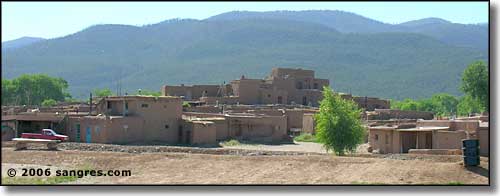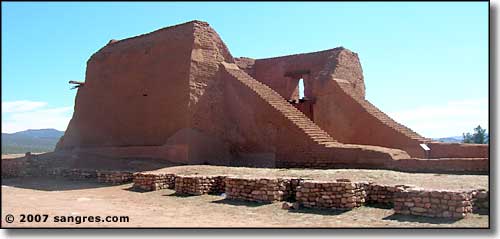 |
The Pueblo Revolt of 1680 |
|
|
 Taos Pueblo today |
|
The Pueblo Revolt of 1680 was brought about by years of Spanish cruelty and barbarism practiced on the indigenous inhabitants. The natives were forbidden, on pain of death, to practice their native religions. The Spanish records even show one instance where dragoons rounded up all the men in Acoma and removed one foot from each of 500 of them to induce them to convert to Christianity. For many Native Americans, the situation got worse every year until a San Juan Pueblo medecine man found a way to get the tribes to cooperate with each other and then face their common enemy: the Spanish. This is a story of revolution. These people fought to regain their freedom from tyranny, persecution and unjust taxation, just like the Americans did 96 years later. For the Pueblo people, though, life was much harder under the Spanish yoke that it was for the American settlers under the English one. The encomienda system in New Mexico allowed the Spaniards to seize a portion (and usually far more than 10%) of every farmer's crop to support Spanish missionary, military and civil institutions. Then there was repartimiento, which provided for forced Indian labor to work in Spanish fields and weaving sweatshops. And then there was the Inquisition: an all-out holy war on anything religious that was not Franciscan Christian that spanned the 17th century and, in New Mexico, provided lots of workers for the Spaniards by declaring many Indians heretics and witches and condemning them to years of slavery. The Americans put up with nothing compared to what these folks went through. But in the end, the Spanish succeeded in provoking these peaceful people into a bloody revolution that ended by throwing the Spanish out for 12 years. When the Spanish came back, they were much more respectful of the people and their native customs and religion... Before 1680: For 10,000 years, people had lived and died in the Rio Grande Valley of northern New Mexico. In the beginning, they were nomadic hunter-gatherers, living off the land as they travelled across it. Then about 4,000 years ago, a traveler from Mexico brought in seeds and farming technology. Slowly, the people learned to farm, and farming required staying in one location, so villages appeared. Men spent more time farming than hunting and women spent more time grinding seeds than gathering berries. Society began to organize. Religions formed, and these religions all held in common the idea of living in harmony with each other, with the land and with the seasons. In those days, real upsets happened only when other Indian tribes came to raid. The worst raiders were the Apache and the Navajos. They were hunter-gatherers who came from the north and they knew nothing of farming. They did know enough that when they raided a village, they didn't kill everyone. They left enough people alive that there would be crops to steal again next year. The raiders were a dangerous nuisance but the situation wasn't bad enough that each of the separate villages would band together to fight. Instead, each village had its own government and tended to its own affairs. There were seven distinct languages spoken by the Puebloan peoples. Tewa, Towa, Tiwa, and Piro all have their roots in the Tanoan tongue, although each is also mutually unintelligible to each other. Zuni, Hopi and Keresan are the other three languages and each is completely unrelated to any of the others. In spite of the language differences, life, religion, food, clothing, weaponry, tools, etc., among the different tribes and villages was very similar. And they all treasured their freedom to be themselves. |
 Remains of the Mission Church at Pecos Pueblo |
|
Then came the Spaniards. The Apaches and Navajos were a serious problem, but they came, they stole and then they left. The Spaniards just kept coming and coming and coming and their objective was to steal everything. As part of this, the Spaniards hired the Apache to seize captives from other tribes to be sold as slaves in Mexico. They paid the Apaches with guns, shot, powder, steel knives, and swords. This allowed the Apache to make more efficient raids on the village people, especially when the village folks were armed only with stone-age weapons. 1598 saw the first arrival of settlers with Don Juan de Oñate. The previous Spaniards had been obvious gold-diggers but these folks were more insidious. They forced the Indians to make things for them. They forced the Indians off their land and then forced them to pay taxes on what they were allowed to keep. There were few Spanish soldiers but many of the Spanish farmers did military service in return for the rights to certain properties and the right to have Indians work the land for them. Essentially, a feudal system was in place with the Spaniards as the lords and the Indians as the serfs and slaves. And there were the Franciscans, the missionaries who were so diligently trying to destroy all vestiges of Indian religion and supplant it with the superior "Christianity." By 1680, there were 40 Spanish churches in northern New Mexico, all built primarily with slave Indian labor. Virtually every Pueblo Indian in New Mexico worked for some Spaniard somewhere for no pay. There was rebellion over the years. In 1630, the Zuni killed a couple of priests. In 1645 in Jemez, there was a revolt planned with the Navajo but after the first Spaniard died, the authorities moved quickly. Before it was over, 29 villagers had been executed while many others were whipped and still others were sold into slavery. Another effort in 1650 got nine more men hanged and many more sold into slavery for ten years. In 1661, the leader of the Franciscans gave orders to the Spaniards to immediately destroy any and all Indian religious objects they came across. This pushed the Indians still closer to a breaking point. In 1670, there was a drought in the land. Because of the Spanish taxes, the tribes had nothing stored up and many people died of hunger that year. The next year brought an epidemic (possibly anthrax) that sickened both cattle and people. The following year was supposed to bring the supply wagon train from Mexico City and Chihuahua. Normally, it took a supply train about six months to lumber over the 1,500 miles of the Camino Real between Mexico City and Santa Fe. The wagon loads were enormous and sometimes took up to 16 slow-moving oxen and mules to move a wagon in particular spots along the way. Once a supply train reached Santa Fe, it waited several months while it was being loaded with hides the Indians had tanned, cloth they had woven, salt they had collected, and one more thing: slaves for the market in Mexico City. Once everything was loaded and made ready, the long wagon train would make its journey back to the center of Spanish civilization in the New World. While the supply train was important to all the Spanish settlers in New Mexico, the supply train of 1680 was extremely important to the Pueblo Indians. |
|
|
 |
| Index - Arizona - Colorado - Idaho - Montana - Nevada - New Mexico - Utah - Wyoming National Forests - National Parks - Scenic Byways - Ski & Snowboard Areas - BLM Sites Wilderness Areas - National Wildlife Refuges - National Trails - Rural Life Sponsor Sangres.com - About Sangres.com - Privacy Policy - Accessibility |
| Photos courtesy of Sangres.com, CCA ShareAlike 3.0 License. Text Copyright © by Sangres.com. All rights reserved. |